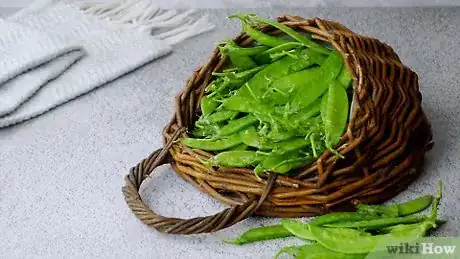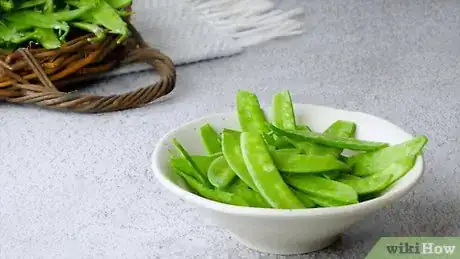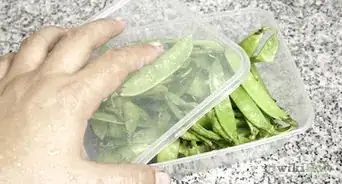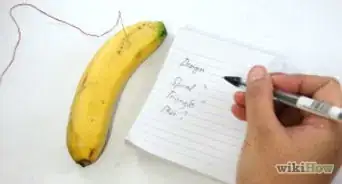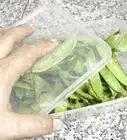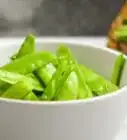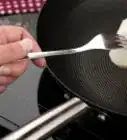wikiHow is a “wiki,” similar to Wikipedia, which means that many of our articles are co-written by multiple authors. To create this article, 18 people, some anonymous, worked to edit and improve it over time.
The wikiHow Culinary Team also followed the article's instructions and verified that they work.
This article has been viewed 210,670 times.
Learn more...
Snow peas are flat pea pods that contain immature peas inside, but because both the pods and seeds are edible and flavorful, you don't have to shell them. You can eat snow peas raw or cooked, making them a versatile vegetable to have in your kitchen. No matter what technique you use to cook them, preparing snow peas only requires a few simple steps.
Steps
Getting the Peas Ready
-
1Choose your snow peas. Snow peas are available in the produce section of most grocery stores. Here's what to look for when selecting snow peas to eat:
- Pick snow peas that are crisp with brightly colored pods.
- Avoid snow peas that are swollen or larger than 3 inches (7.6 cm) long--they tend to be tough.[1]
- Also avoid snow peas that are dry along the edges, have yellow spots, or are wrinkled.
- Snow peas that are in a sealed container and refrigerated can be stored for several days.
-
2Rinse the snow peas. Place the snow peas in a colander and rinse in running cold water, swirling the peas.
- As an alternative, you can immerse a colander of snow peas in a bowl of cold water and swirl.
Advertisement -
3Trim the snow peas. It's important to trim off the stems of snow peas because the stems will be tough.
- The stem end will have a small cap on the end, perhaps with a short stem attached.
- Leave the other end (the end with a slight curl to it) intact for now. You'll need it to help you remove the “string.”
-
4Remove the “string.” The “string” of the pod makes the snow pea stiff and tough, and removing it allows the snow peas to become more tender.
- Pinch the curly end of the snow pea. Hold the snow pea and grasp the small curl at the bottom of the pod. Pinch it until it is completely off. If you have trouble removing the end, use a small knife to help you.
- Grasping the curly end, pull it downward along the pod to remove the “string.”
Cutting the Peas
-
1Slice the snow peas makes them easier to handle and to eat. You can slice the peas into thin strips lengthwise (julienne) for use in a marinated salad, a spring salad, lumpia, tacos, or pasta.
- For instructions on how to julienne vegetables, see How to Julienne.
-
2Cut the peas in half on the bias (that is, not straight across but at a diagonal). Cutting on the bias exposes more surface area of the vegetable for cooking.
- Hold the blade of your knife so that it's at an angle to the pea.
- Slice down with the blade to cut the pea in half, making sure to keep the blade angled so the resulting cut goes diagonally across the pea.
- The greater the angle of your cut, the greater the surface area of the pea that will be exposed for cooking.
- Continue cutting the rest of the peas on the bias, making sure that the pieces are all approximately the same size.
-
3Use them whole. Snow peas can also be served whole. There are several uses for whole snow peas, including:
- Using raw snow peas as dippers for hummus or ranch or to add crunch to a salad.
- Snow peas as a side dish. You can serve whole snow peas glazed, sauteed, stir-fried, or steamed.
Seasoning and Cooking
-
1Season with olive oil. Olive oil is a great base for seasoning and cooking snow peas.
- To season with olive oil, drizzle the oil over the snow peas, then add salt and pepper to taste. Snow peas prepared this way may be eaten raw, if you choose.
- To cook snow peas with olive oil, add about a tablespoon of oil to a pan under medium-high heat. When the oil is hot, add the snow peas along with salt and pepper to taste and cook for 3 to 5 minutes, until the peas are bright and crisp.[2]
-
2Season with Italian seasoning. Italian seasoning is a spice blend available at most grocery stores. It is a great blend to use on snow peas.
- Heat a tablespoon of olive oil in a pan over medium-high heat.
- Optional: add a clove of minced garlic and cook for a minute or two until fragrant.
- Add the snow peas, 1/2 teaspoon Italian seasoning, a tablespoon of water and cook until the peas are brightly colored, about two minutes.
- Optional: add salt and pepper to taste.[3]
-
3Season with salt. Boiled and lightly salted snow peas make a great snack or vegetable dipper.
- Place snow peas in a medium-sized pot.
- Add water to the pot until the snow peas are covered.
- Boil until they're bright and tender, about 1 to 2 minutes.
- Drain the snow peas and season with salt.
Community Q&A
-
QuestionCan snow peas be frozen? How would I do it?
 Community AnswerHere are the quick and easy steps to freeze snap or snow peas without blanching: Strip pods of the tops and strings, as usual. Clean if needed and dry well. Slice pods into 1-2 inch pieces. Add them to a freezer baggie, remove air, label the bag, and freeze.
Community AnswerHere are the quick and easy steps to freeze snap or snow peas without blanching: Strip pods of the tops and strings, as usual. Clean if needed and dry well. Slice pods into 1-2 inch pieces. Add them to a freezer baggie, remove air, label the bag, and freeze. -
QuestionIs it possible to cook them without the salt and oil?
 Community AnswerIf you're cooking them in a pan, it's best to use some oil. Boiling the peas does not require oil. Salt and seasonings do add flavor, so season to your own taste! If you think they taste fine with little or no salt, then feel free to omit it or substitute a different spice.
Community AnswerIf you're cooking them in a pan, it's best to use some oil. Boiling the peas does not require oil. Salt and seasonings do add flavor, so season to your own taste! If you think they taste fine with little or no salt, then feel free to omit it or substitute a different spice. -
QuestionCan eating untrimmed snow peas be harmful?
 Community AnswerEating untrimmed snow peas isn't harmful. However, the stems and strings are very tough and are not particularly pleasant to eat.
Community AnswerEating untrimmed snow peas isn't harmful. However, the stems and strings are very tough and are not particularly pleasant to eat.
References
About This Article
To prepare snow peas for cooking, first rinse them in a colander to get rid of any dirt or bacteria. Then, trim the tops and tails of each snow pea with scissors or a knife. If you like your snow peas a little tougher, you can cook them like that. However, if you prefer them a little softer, leave the tail on each snow pea when you’re cutting them. Use this to pull the string from the top of each snow pea. Then, slice the snow peas into thin strips and add them to a salad or stir fry, or cook them on their own. For more tips, including how to season your snow peas, read on!
